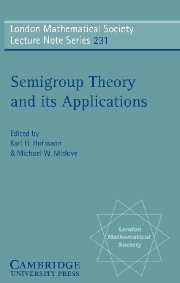 Semigroup Theory and its Applications
Semigroup Theory and its Applications Book contents
Isbell's zigzag theorem and its consequences
Published online by Cambridge University Press: 05 April 2013
Summary
Introduction
It is a great pleasure and privilege to be speaking at a conference in memory of A H Clifford, who has unquestionably been one of the main influences on my mathematical work. I met him first nearly thirty years ago, in September 1964, when I began my very enjoyable and mathematically very fruitful year at Tulane.
Perhaps strangely, the theorem I want to talk about was not proved either by me or by Clifford. I proved the theorem for commutative semigroups, but the much deeper and more difficult result for semigroups in general was proved by John Isbell [17], who also spent Session 1964–65 at Tulane. In this brief survey I shall give only sample proofs.
Epimorphism and Dominions
Let me set the scene. In many branches of algebra the term epimorphism is used to denote an onto homomorphism. However, in category theory an epimorphism α : A → B is defined by a cancellation property: for all objects C in the category and all morphisms β, γ : B → C,
It is clear that in semigroup theory every onto morphism is an epimorphism: if α is onto, then aαβ = aα7gamma; for all a in A implies that bβ = bγ for all b in B; for every b is expressible as aα. However, while the converse result is true in groups, it is not true in rings or in semigroups. Many examples will emerge as we proceed.
Isbell's first major contribution was to introduce a related idea. Let U be a subsemigroup of a semigroup S. Let d ∈ S.
- Type
- Chapter
- Information
- Semigroup Theory and its ApplicationsProceedings of the 1994 Conference Commemorating the Work of Alfred H. Clifford, pp. 81 - 92Publisher: Cambridge University PressPrint publication year: 1996
- 1
- Cited by
